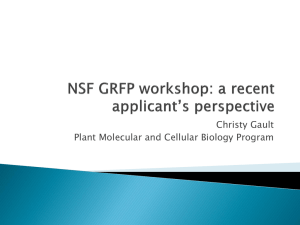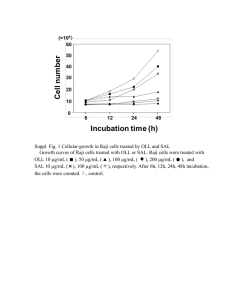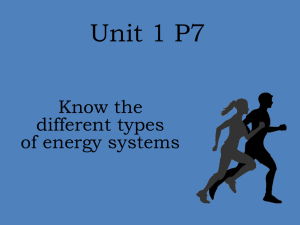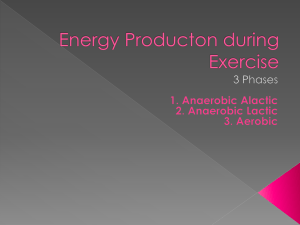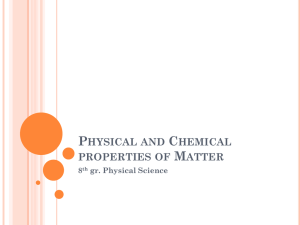Chapter 16 questions
advertisement
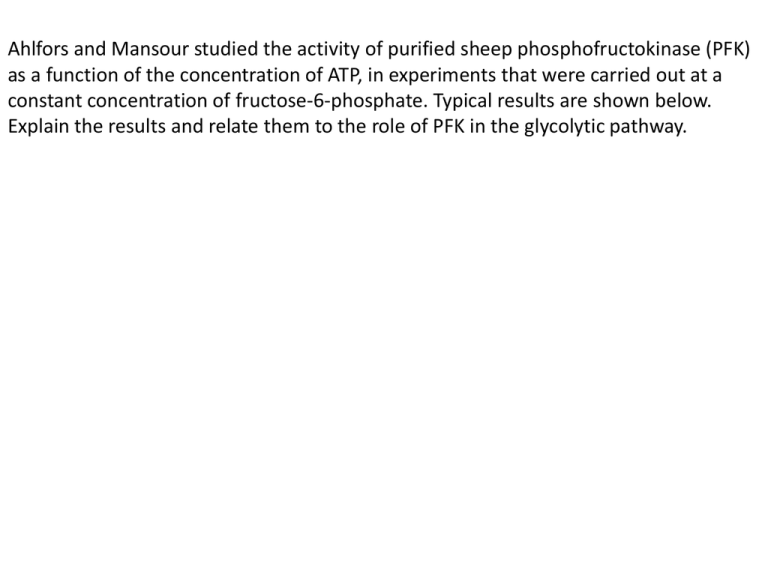
Ahlfors and Mansour studied the activity of purified sheep phosphofructokinase (PFK) as a function of the concentration of ATP, in experiments that were carried out at a constant concentration of fructose-6-phosphate. Typical results are shown below. Explain the results and relate them to the role of PFK in the glycolytic pathway. PFK catalyzes the phosphorylation of fructose-6-phosphate by ATP to form fructose-1,6bisphosphate. ATP serves as a substrate for the reaction. At low [ATP] the rate of reaction increases with increasing [ATP]. As the [ATP] increases the rate of reaction reaches a maximum at about 0.1 mM ATP then the rate rapidly decreases. ATP serves as both a substrate and an allosteric inhibitor of PFK. There are two binding sites on PFK for ATP. One site is a substrate site and the second site is an inhibitor site. PFK is an allosteric enzyme whose T and R states are in equilibrium. ATP binds to the substrate site equally well when PFK is either in the T or the R state. ATP will bind in the inhibitor site almost exclusively when PFK is in the T state. PFK catalyzes the committed step of the glycolytic pathway. As part of catabolism, glycolysis produces ATP. Elevated levels of ATP inhibit many catabolic enzymes. ATP serves as a signal of energy level in the cell. When ATP is abundant the cell has an abundant supply of energy and enzymes in pathways that produce energy such as PFK are inhibited. Researchers have mutated Cys149 in glyceraldehyde 3-phosphate dehydrogenase (GAPDH) to determine the role of the side chain in the GAPDH reaction. Upon mutation of Cys149 to Serine, the catalytic activity of GADPH decreases over 104-fold. The dehydrogenase activity was pH sensitive. Base titration of the wild type enzyme resulted in activity with a single pKa near 7.2, while the activity of the Cys149 to Ser mutant increased linearly with pH and did not show a titratable proton below pH 10. a. What can you conclude about the wild type protein from this pH study, i.e. explain the observations above? Researchers have mutated Cys149 in glyceraldehyde 3-phosphate dehydrogenase (GAPDH) to determine the role of the side chain in the GAPDH reaction. Upon mutation of Cys149 to Serine, the catalytic activity of GADPH decreases over 104-fold. The dehydrogenase activity was pH sensitive. Base titration of the wild type enzyme resulted in activity with a single pKa near 7.2, while the activity of the Cys149 to Ser mutant increased linearly with pH and did not show a titratable proton below pH 10. a. What can you conclude about the wild type protein from this pH study, i.e. explain the observations above? The wild type pH results suggest a vital (probably) nucleophilic) group needs to be deprotonated for maximum activity. The range might suggest His, Cys or maybe even Asp and Glu. The results of the mutation point to Cys. Researchers have mutated Cys149 in glyceraldehyde 3-phosphate dehydrogenase (GAPDH) to determine the role of the side chain in the GAPDH reaction. Upon mutation of Cys149 to Serine, the catalytic activity of GADPH decreases over 104-fold. The dehydrogenase activity was pH sensitive. Base titration of the wild type enzyme resulted in activity with a single pKa near 7.2, while the activity of the Cys149 to Ser mutant increased linearly with pH and did not show a titratable proton below pH 10. b. Since Ser can act as a nucleophile in the Serine protease mechanism, why is it unable to catalyze this reaction? Researchers have mutated Cys149 in glyceraldehyde 3-phosphate dehydrogenase (GAPDH) to determine the role of the side chain in the GAPDH reaction. Upon mutation of Cys149 to Serine, the catalytic activity of GADPH decreases over 104-fold. The dehydrogenase activity was pH sensitive. Base titration of the wild type enzyme resulted in activity with a single pKa near 7.2, while the activity of the Cys149 to Ser mutant increased linearly with pH and did not show a titratable proton below pH 10. b. Since Ser can act as a nucleophile in the Serine protease mechanism, why is it unable to catalyze this reaction? Clearly the “catalytic traid” that activates Ser as a nucleophile by reducing its pK is not present here. The gradual increase reflects the fact that the serine pK is normally VERY high (12-13+). Researchers have mutated Cys149 in glyceraldehyde 3-phosphate dehydrogenase (GAPDH) to determine the role of the side chain in the GAPDH reaction. Upon mutation of Cys149 to Serine, the catalytic activity of GADPH decreases over 104-fold. The dehydrogenase activity was pH sensitive. Base titration of the wild type enzyme resulted in activity with a single pKa near 7.2, while the activity of the Cys149 to Ser mutant increased linearly with pH and did not show a titratable proton below pH 10. c. What effect would such a mutation have on glycolysis in living cells? Researchers have mutated Cys149 in glyceraldehyde 3-phosphate dehydrogenase (GAPDH) to determine the role of the side chain in the GAPDH reaction. Upon mutation of Cys149 to Serine, the catalytic activity of GADPH decreases over 104-fold. The dehydrogenase activity was pH sensitive. Base titration of the wild type enzyme resulted in activity with a single pKa near 7.2, while the activity of the Cys149 to Ser mutant increased linearly with pH and did not show a titratable proton below pH 10. c. What effect would such a mutation have on glycolysis in living cells? This would reduce flux through the pathway reducing the ability to effectively use sugars. It is likely to be fatal. In muscle, lactate dehydrogenase produces lactate from pyruvate, whereas in the heart it preferentially synthesizes pyruvate to lactate. Explain how this is possible. In muscle, lactate dehydrogenase produces lactate from pyruvate, whereas in the heart it preferentially synthesizes pyruvate to lactate. Explain how this is possible. Muscle and heart have two distinct LDH’s Heart mostly H-type subunits. This enzyme has higher affinity for substrate and inhibited by very high concentrations of pyruvate.. Therefore it is destined to make lactate from pyruvate… Muscle LDH has mostly M-type subunits and more destined to make pyruvate from lactate.
